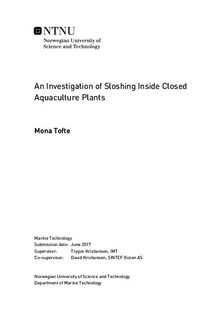| dc.description.abstract | In the present work sloshing inside closed aquaculture plants at sea has been investigated by both experimental methods and linear sloshing theory.
An experiment conducted in the student towing tank at NTNU during the project thesis fall 2016 investigating sloshing inside a closed upright circular cylindrical fish tank subjected to regular waves is presented and re-analysed. Two degrees of freedom were considered in the experiment, surge and pitch.
For a closed aquaculture plant with a free-surface, the natural sloshing frequencies and corresponding natural modes are non-trivial solutions of the boundary value problem for the liquid inside the plant with zero plant excitation.
The experimental results showed that violent sloshing occurs for an incoming wave frequency which is 6.4% higher than the natural frequency of the first sloshing mode. This is due to coupling with the motions of the model. At incident wave frequency, the body-fixed response amplitude of the free-surface elevation inside the model is measured to be 3-4 times larger than the incoming wave amplitude.
The free-surface elevation inside the cage is simulated with linear modal theory, assuming prescribed motions measured in the experiment. Comparing with the experimental free-surface elevation, the numerical results were not satisfactory. Because of unreliable measurements of the motions in the experiment, the sensitivity of the response of the numerical free-surface elevation inside the model was investigated regarding the prescribed motions. The sensitivity of the response of the numerical free-surface elevation inside the fish cage is high in the vicinity of the natural frequency of the first sloshing mode.
Based on the sensitivity analysis, corrections of the motions were made and the free-surface elevation was calculated with the new motions. The numerical and experimental free-surface elevation inside the plant do now coincide for a large frequency domain and the violent sloshing response is predicted well by the linear modal theory. Still, the experimental and numerical results do not fully agree in the vicinity of the natural frequency of the first mode.
Investigation of time series of the experimental free-surface elevation identified rotary wave motions inside the model known as swirling. A nonlinear analysis of the experimental data was performed and showed that nonlinearities were present in the vicinity of the natural frequency of the first sloshing mode. Resonant sloshing is a highly nonlinear phenomenon and linear sloshing theory has therefore strong limitations when it comes to estimating the sloshing response in the vicinity of the natural frequency of the first sloshing mode. However, linear sloshing theory gives useful results for nonresonant sloshing. | |

